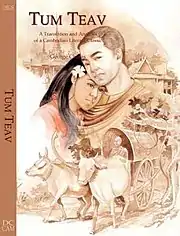Tum Teav
Tum Teav (Khmer: ទុំទាវ) is a romantic tragedy novel written by Phikhu Nguon Soam about caste love during the Longvek period in 1572 during the reign of King Borom Reachea II. The work of Phikhu Nguon Soam was included by King Sisowath as a national literary work in 1928, consisting of 1050 verses, 118 pages. His work has been recognized by international writers as being compared to the famous European novel "Romeo and Juliet" and the famous Chinese novel The Butterfly Lovers. (Chinese: 梁祝) with characters named "Liang Shanbo and Zhu Yingtai" Tum Teav was translated by Frank Stewart in 1942 in In the Shadow of Angkor.[1]
| Author | Phikhu Nguon Soam |
|---|---|
| Country | Cambodia |
| Language | Khmer |
Publication date | 1915 |
Tum Teav Becomes a Popular National Literary Story
Tum Teav is a famous novel in Cambodia that has been translated and published by a group of writers, including "Oknha Vibol Reach Sena Nukon", who has translated and re-edited the story of Teav Ek. Replaced as the reign of King Reamea Cheung Prey (1594-1596), this story was published in 1949.[2] Tum Teav was included in the curriculum during the Sangkum Reas Niyum era in the 1960s as a work of Khmer literature in the text of the story and the story, which was recited as a seven-word poem, in which Mr. Kong Huot and Mr. Chao Seng, published by Sihanoukville Buddhist University.[3] Tum Teav was also included in the Yike theatrical form in 1965, within the framework of the Cambodia Royal University of Fine Arts. Until 1969, Tum Teav was also screened at international festivals in Malaysia, and the Philippines during the Khmer Republic in 1970.[4]
Romantic Epic
Tum Teav is an important novel that is included in the literary works of romantic poems of the ancient Khmer style, one of the most well-known and beloved poems that incorporate the character of the characters. Each and the heroism of the characters demanding freedom and justice, which is considered to be the best in Khmer literature, as well as in the Western novel "Romantic Epic".[5]
Although its first translation in French had been made by Étienne Aymonier already in 1880, Tum Teav was popularized abroad when writer George Chigas translated the 1915 literary version by the venerable Buddhist monk Preah Botumthera Som or, Som one of the best writers in the Khmer language.[6]
Plot

The tale relates the encounters of a musically talented, novice Buddhist monk named Tum and a girl named Teav. During his travels from Ba Phnum, Prey Veng province, to the province of Tbaung Khmum, where he has gone to sell bamboo rice containers for his pagoda, Tum falls in love with Teav, a very beautiful young lady who is drawn to his beautiful singing voice. She reciprocates his feelings and offers Tum some betel and a blanket as evidence of her affections. Upon returning to his home province, Tum is consumed with longing for Teav and soon returns to Tbaung Khmum. Soon afterward, he is recruited by King Rama to sing at the royal palace, and he leaves Teav once again.
Teav's mother is unaware of her daughter's love for the young monk, and in the meantime she has agreed to marry her daughter off to the son of Archoun, the powerful governor of the province. Her plans are interrupted, however, when emissaries of Rama—equally impressed by Teav's beauty—insist that she marry the Cambodian king instead. Archoun agrees to cancel his son's wedding arrangement, and Teav is brought to the palace. When Tum sees that Teav is to marry the king, he boldly sings a song that professes his love for her. Rama overcomes his initial anger and agrees to allow the young couple to marry.
Enraged, Archoun commands his guards to kill Tum, who is beaten to death under a Bo tree. Grief-stricken, Teav slits her own throat and collapses on Tum's body. When Rama hears of the murder, he descends upon Archoun's palace, ignores the governor's pleas for mercy, and orders Archoun's entire family—including seven generations worth of relatives—be taken to a field and buried to their necks. An iron plow and harrow are then used to decapitate them all.[7]
Analysis
Critical scholarship using Tum Teav is diverse. Tum Teav was the exemplary text in a 1998 article, "A Head for an Eye: Revenge in the Cambodian Genocide,"[8] by Alexander Laban Hinton that tries to understand anthropological motivations for the scale of violence perpetrated by the Khmer Rouge. That article reads in Tum Teav a cultural model of karsângsoek, or "disproportionate revenge." Ârchoun's murder of Tum, a blow to the authority of the King, is returned by the genocide of Ârchoun's line: "a head for an eye."
In 2000, the music production company Rasmey Hang Meas adapted the story into a full-length karaoke musical on DVD.[9]
In 2003, the story was again adapted into a two-hour film directed by Fay Sam Ang.[10]
References
- Frank Stewart (1942). In the Shadow of Angkor. Honolulu University of Hawaii Press, 2004. p. 220. ISBN 0824828496.
- Vipulrājasenā (Nū Kan) (1949). Rẏaṅ Dāv Ek, Volume 1. Bhnaṃ beñ : Roṅ Bumb Khemaraṭṭh, the University of Michigan.
- Kong Huot, Chau Séng (1969). Tum-Teav: adapté du poème cambodgien Issue 7 of Séries culture et civilisation khmères. Université bouddhique Preah Sihanouk Raj: the University of Wisconsin - Madison. p. 90.
- Khmer-renaissance chapter-seven Yeike Ta Ki (1965-1970), by yosothor.org
- Russell A. Judkins, editor. (1988). First International Scholars Conference on Cambodia: Selected Papers. Anthropology Department, State University of New York at Geneseo. p. 73. ISBN 0961791519.
- Documentation Center of Cambodia - Tum Teav: A Translation and Analysis of a Cambodian Literary Classic
- Our Books » Tum Teav Archived 2007-09-30 at the Wayback Machine
- Hinton, Alexander Laban (1998). "A Head for an Eye: Revenge in the Cambodian Genocide". American Ethnologist. 25 (3): 352–377. doi:10.1525/ae.1998.25.3.352. JSTOR 645789.
- "Khmer440".
- http://seassi.wisc.edu/Activities/SEASSI%20Film%20Series%202005.pdf